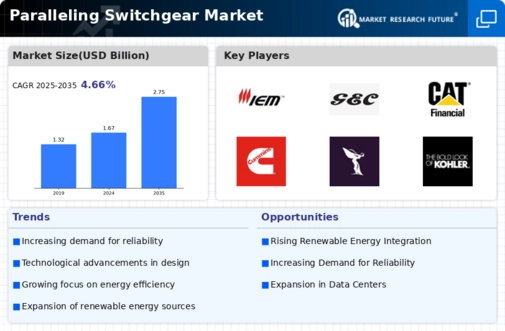Market Trends
Key Emerging Trends in the Paralleling Switchgear Market
In the dynamic context of the Paralleling Switchgear Market, firms employ various strategies to gain market share and standout in a competitive market. One of the most common ways of doing this is differentiation where manufacturers focus on providing unique features and modern technologies in their paralleling switchgear systems. This not only attracts customers who are looking for dependable and efficient power distribution solutions but also helps companies establish themselves with a distinct brand image in the market place. For instance, manufacturers may invest in developing paralleling switchgear with advanced control systems, real-time monitoring capabilities and seamless integration with renewable energy sources which meet the increasing demand for smartly flexible power distribution solutions.
Another important strategy in the Paralleling Switchgear Market is cost leadership. Companies intend to be low-cost producers by optimizing manufacturing processes, being efficient when sourcing material as well as exploiting economies of scale. Providing cost-effective paralleling switchgear responds to clients who want to optimize their investment on power distribution infrastructure without compromising reliability or safety. However, keeping cost leadership requires a delicate balance that ensures that quality, performance or innovation is not compromised by cost-cutting measures.
The concept of market segmentation plays an important role when it comes to determining how companies should position themselves so as to increase their portion in Paralleling Switchgear sales. They customize their products according to specific customer segments’, industries’ and applications’ requirements. For example, they may design parallel switch gears suitable for hospitals, IT centers, industries or offices buildings with different characteristics aimed at meeting specific needs within those environments. Such an approach enables firms penetrate particular sub-markets hence taking greater share of the whole sector.
Furthermore, collaboration and strategic partnerships are key elements of market positioning for Share gear in Paralleling Secondary Distribution Applications System Markets internationally especially US Companies often enter into alliances with electrical contractors/ installers involving system integrators or other players within its ecosystem in order to enhance its standing among its target consumers (market share positioning). The collaborations may result into research undertakings together. With this, the company ensures that its paralleling switchgear systems comply with the changing industry norms and customer expectations. Additionally, involvement of power-management solution suppliers or energy-efficiency advisors further enriches the overall switch gear solution by ensuring they meet all the needs of end-users.











Leave a Comment